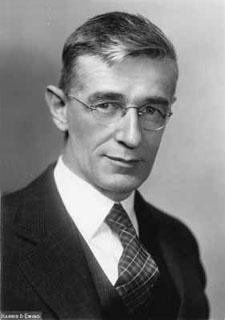Reflection of the week: As We May Think by Vannevar Bush
By Jesse van der Merwe,
About the Author

Vannevar Bush (1890 – 1974) was an American engineer, scientist and inventor. He headed the Office of Scientific Research and Development (OSRD) before and during World War II. The OSRD was responsible for the Manhattan Project. Later in life, he became the vice president of Massachusetts Institute of Technology (MIT) and dean of the MIT School of Engineering.
My Reflection About the Article
Vannevar Bush seemed to be a man who thought that violent and destructive scientific/technological inventions were necessary during the World War(s). However, he also believed that these scientific/technological inventions could and should rather be used to lead towards understanding/research/development etc. One of his primary concerns is that in times of peace, scientists will have no motivation/cause to pursue their profession with the same zeal or commitment as during times of war. Another concern was that, even during his time, there was too much information for any one person to sort through and/or analyse.
Bush then goes on to suggest – or rather predict – many gadgets/machines of the future; many of which have indeed materialised in some form. The first gadget mentioned in this article is that of a walnut sized camera, positioned on a person’s forehead, used to capture what the wearer sees. This is indeed the basic idea behind many such ‘smart glasses’ today such as Google Glass by Google or even the comparatively inexpensive Focals by North (coming 2020). Bush made further predictions about photography and film – specifically that the storage of photos will become smaller and immediate – with the ability to store hundreds or even thousands of such photos or book pages etc. in a tiny area.
However, Bush then states that the mass storage of such information means very little if there is no efficient or quick way or organising and the accessing such information. This lead on to arguably his most impressive prediction – the “memex”. He describes this machine as a desk in appearance, that would have the ability to immediately bring any file or material on any subject to the operator via translucent viewing screens that magnify supermicrofilm. It would also allow for the operator to automatically photograph notes, pictures, letters, files, etc. to be stored in the desk for future reference. This invention sounds very much like the modern-day desktop computer – information on a hard drive that is accessed and displayed on screen(s). However, once again Bush goes on to mention that unless the data/information can be linked and analysed, there is not much point to having such vast storage. He then goes on to describe how the “memex” would be able to create permanent trails between any such file/picture/etc. stored within it. This is effectively the equivalent of the hyperlink used throughout the World Wide Web.
The inventions and predictions made by Bush when this article was written are truly inspirational considering how much technology has indeed advanced since then.
